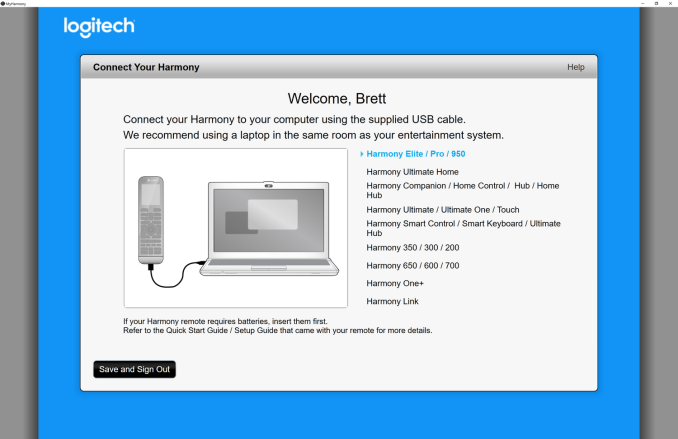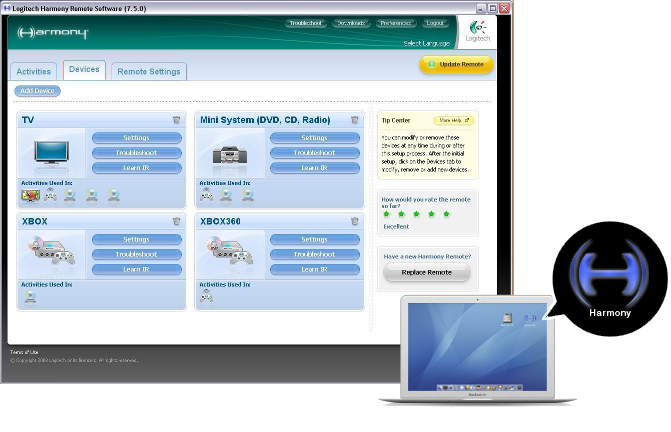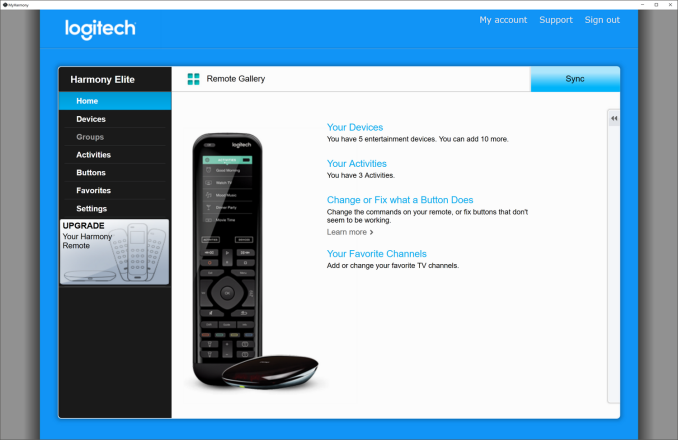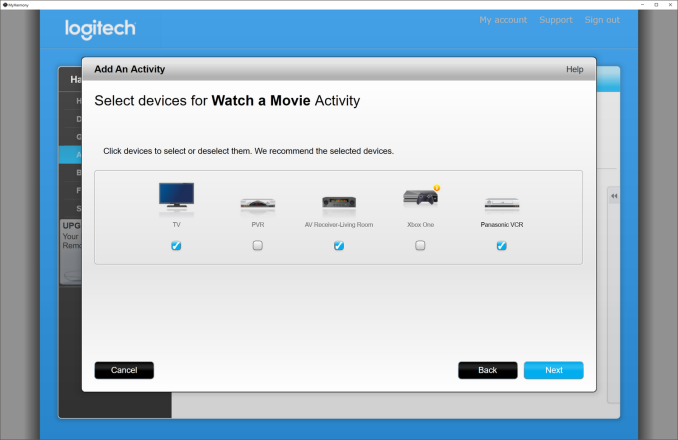The Logitech Harmony Elite Experience: Ultimate Control
by Brett Howse on February 14, 2017 8:00 AM EST- Posted in
- Accessories
- Logitech
- Remote Control
- IoT
- Smart Home
- Harmony
Programming The Remote
Whether you use the smartphone app, or the PC application, the basic process of setting up a Harmony is practically the same. The app contains the instructions on initial setup, and if you’re using a PC, you have to connect the remote to your PC using a USB cable, but if you’re using the smartphone app that’s not necessary. It recommends using a laptop in the same room as your TV, and that makes a lot of sense especially for the older Harmony remotes, but with the ability to reprogram the Elite using the Hub, you can make changes at any time and save them.
Basically, the entire point of hooking the remote up the computer is so that you can join the hub to your Wi-Fi network. Once that step is complete, you can add your devices regardless of whether the remote is connected to the computer. The initial setup is likely the one stumbling block that Logitech has worked hard on making smooth, and the latest software version really is a big step forward in usability.
What the Harmony software used to look like
Once you’re ready to add devices, select the Devices tab for a view of what you have added, and how you can add more. You can add traditional devices, or the Harmony Hub can scan your network for devices to add automatically. Without creating a tutorial on the setup, which of course Logitech already has, when you add a device, it asks for the manufacturer, and the model number, and the software shows you in animated images examples of where to find the model number. You can also add a Windows or Mac computer, which will allow you to use the remote as a virtual keyboard, and it connects over Bluetooth.
 And the new software looks much better
And the new software looks much better
This step is where the huge database, built up over years, really plays into the Harmony’s favor. Harmony now boasts over 270,000 entertainment and smart home devices in their database, so odds are that if you search for it, they will already have the device’s control mapped out. If for some reason they don’t have the device listed, you can also have the remote learn the IR commands from the original remote. This is certainly a tedious process, but luckily, it’s not called upon very often.
Once you get your devices added, you can group them into activities on the Activities tab. Just select Add Activity, and then run through the steps depending on what you are up to. If you’re adding “Watch a Movie”, for instance, you’ll select what input for the TV to be on, what devices to be powered on, what input for the A/V receiver, and what controls the volume. You can change the icon as well from the standard one to a JPEG or PNG image.
Once you have your activities mapped out, you’re done. Sync the remote to the hub, and give it a try. The Harmony Elite features on-screen troubleshooting steps if something doesn’t function, but that is only for if a device is on, and on the right input. If one of the activities is missing steps, or controlling the wrong device, you’ll have to use the app or software to sort that out.
If you’re into technology, the Harmony setup is easier than it sounds. The biggest things are to know your model numbers, and how your gear is connected. If you have that knowledge, or can get it, the process is pretty straightforward. I’m not sure how Logitech can make it much simpler than it already is, but it’s definitely the one part of the usage that would deter a lot of people.













99 Comments
View All Comments
JeffS - Wednesday, February 15, 2017 - link
We have had a Harmony Elite in our home theater for a year now, and it has been a really fantastic product. My wife was basically afraid of using the system until we got this remote, and now she has no problem using it even when I'm not home. The hard buttons are all intuitive, and the touch screen really makes it work. We don't have a particularly complex system and are probably the perfect target customer for the product, but it is complex enough to require multiple remotes if you don't use the Harmony. There's an Epson projector, an Integra AV receiver, a TiVo Mini, a current-gen Apple TV, and a Blu-ray player. The activities on the touch screen are straightforward- "Watch Apple TV," for example, does everything you'd expect. The IR blasters flood the entire room and are so powerful that even reflected IR from the walls controls components. When you're done, the hard "off" button shuts everything down cleanly so that the projector isn't left idling and using up bulb life.We have a lot of tech gadgets in our house. This one is near the top of the list for reliability and ease of use.
fanofanand - Wednesday, February 15, 2017 - link
I'm trying to imagine how ticked off I would be when my kids misplaced a $300 remote.Ratman6161 - Wednesday, February 15, 2017 - link
So, $300 is way more than I'm willing to spend. But I'm intrigued by the hub part which can be purchased separately ($96 on Amazon). Anyone using just the hub and the app without the actual remote?As to the limitations mentioned for the app, I have an older (from 2013) Android phone that doesn't have cell service and continues (at least for now Its android 4.4.4) to run current apps. So if I use this old phone as my remote, or my tablet for that matter, I'm thinking I wouldn't really need the actual remote.
Anyone actually tried this?
rmack350 - Wednesday, February 15, 2017 - link
I also have a Harmony Companion and feel that the Less is More aspect of it works really well. But the specs listed are wrong.The Companion is an RF remote with a coin battery. The coin is supposed to last a year but mine has lasted longer. No recharging required. You can use it anywhere and don't need to be within line of sight, and the remote is simple. The basic learning curve is really short. Honestly, I just use it for TV/STB, TV/Roku. and TV/BlueRay. It has three function buttons for that and you could assign different functions to them for short and long presses but I just skipped the long presses. I bought the thing to simplify the remotes, after all.
The cool thing here is the hub. It's actually the IR emitter and it just flashes the signal at the entire room. It's pretty much always got line of sight this way and it makes the remote more reliable. The problem with a universal remote is that it has to send a set of codes to each device it's controlling. Very often the user would set the remote down out of line of sight before it was finished. Pushing the signalling to the hub gets rid of that fail point. It's very reliable.
There are very few flaws to the Companion remote, except that the buttons are small and unlit. If it weren't for that the companion would make a great gift for elderly people.
CircuitWizardry - Thursday, February 16, 2017 - link
The lack of a hard number pad is a major fail in my opinion. I much prefer to quickly type in the 3 numbers of a channel I want to go to, than use a guide, or a favorite channel list, where I have to look down at a screen on the remote.In my opinion, they had the physical layout correct with the Harmony 900, and it included a blaster. I own three aging 900's, and the IP control would be a nice addition for several devices, but I'll deal with the occasional issue, in exchange for having the numpad.
The real competitor to Harmony is URC, but they won't allow end users access to their programming software... so my money goes elsewhere.
ceomrman - Thursday, February 16, 2017 - link
This whole thing makes me feel old. I used to love this hyper-complicated stuff. I had a Harmony back in the day, but now I use the stock TV remote only, 100% of the time. I have a very good 2.1 system plugged into a mid-range AVR plugged into a smart TV that has Plex and Netflix and Youtube apps. I press "on" and everything fires up. Two presses later and I'm looking at an app menu or watching TV. No need for a hub, since the line of sight to the TV is never a problem. I can adjust my LED lights with their free app. I do sometimes miss the AVR remote for changing the sub level, so I do have to twirl that little knob a couple times a year. Sometimes we put on the radio, but usually for a party or cleaning or something, when using the input knob is no more PITA than using the remote. Sound modes and stuff are gimmicks. I listen to the sound how it was recorded, or admittedly down-mixed if was encoded only in surround. Why would you want to listen to a club mix in Stadium mode? If the movie should have rumbley bass, it'll have it. I've never had any complaint beyond the occasional crappy over-compressed file quality. When we want TV, pressing the "on" button on the remote automatically preempts the radio. I just can't think of what I'd do with a disc player, or what else I'd like a universal remote to do for me. I suppose it'd be nice to control a Roku, but what I'd really like for that (and for the other SnartTV apps, actually) is QWERTY, which Logitech doesn't help with.Kakureru - Friday, February 17, 2017 - link
Ug, still using that garbage "cloud" based software. I need it to 1' work entirly offline without an harmony account, 2, a way to manipulate the codes directly as the software keeps misinterpreting what actually is learned in.Kakureru - Friday, February 17, 2017 - link
Also, I require ACTUAL macros that control my devices AND the remote itself. The "activities" thing does not do what I want.beyondtool - Saturday, February 18, 2017 - link
I cannot fathom why the battery life is still so abysmal. It's definitely the sore point of my Harmony one, over the years there have been many frustrating hours waiting for the damn thing to charge its special battery. It's enough to go back to multiple remotes, rather than pay $300 for this replacement...stangflyer - Saturday, February 18, 2017 - link
I use my Harmony and hub along with an Echo dot to do everything by voice. Now I can pause, forward, reverse anything from my Tivo,UHD player and Roku Ultra. The only thing I have to do is put the disc in the tray as it automatically opens and closes the tray after 10 seconds.